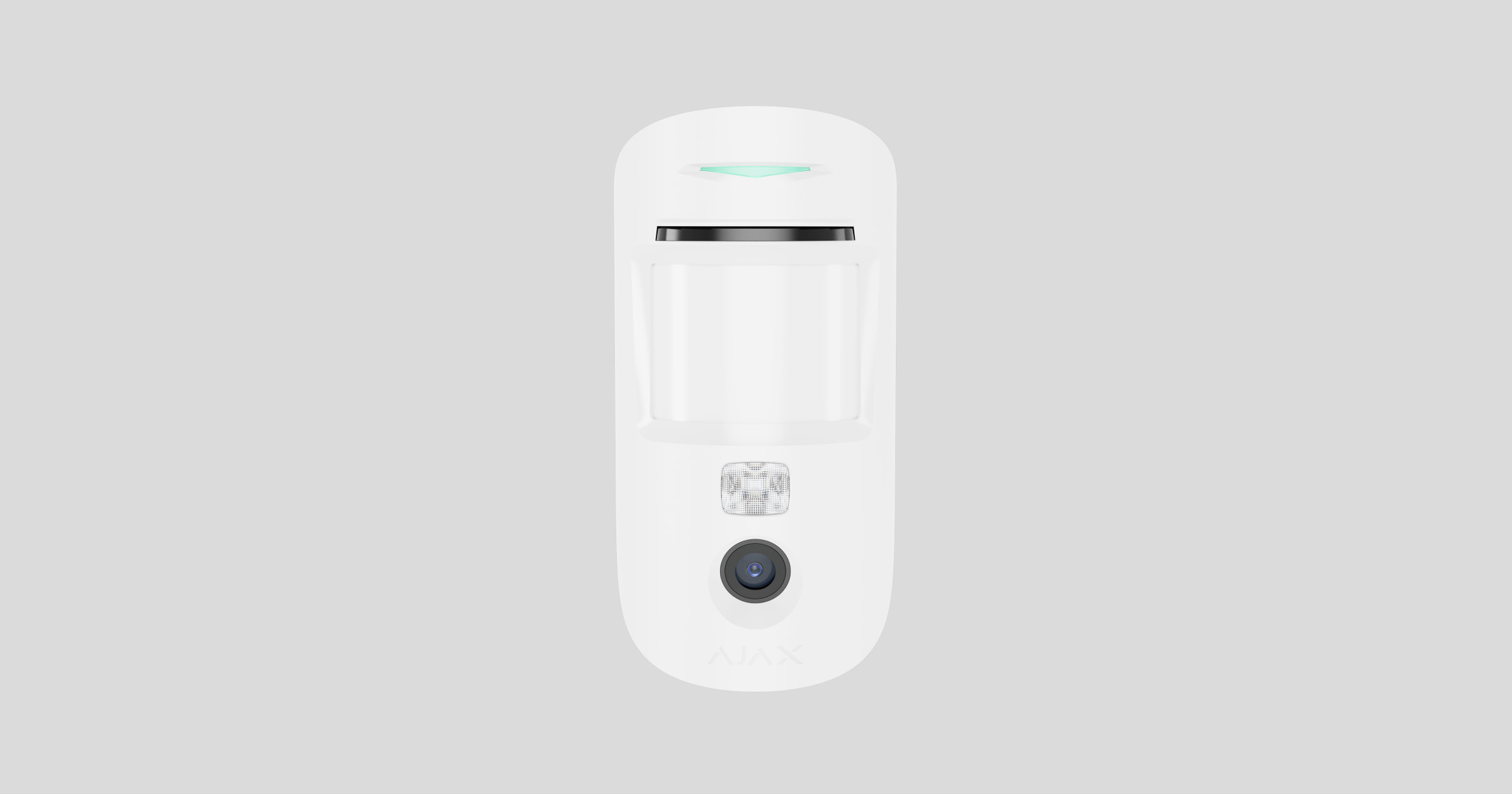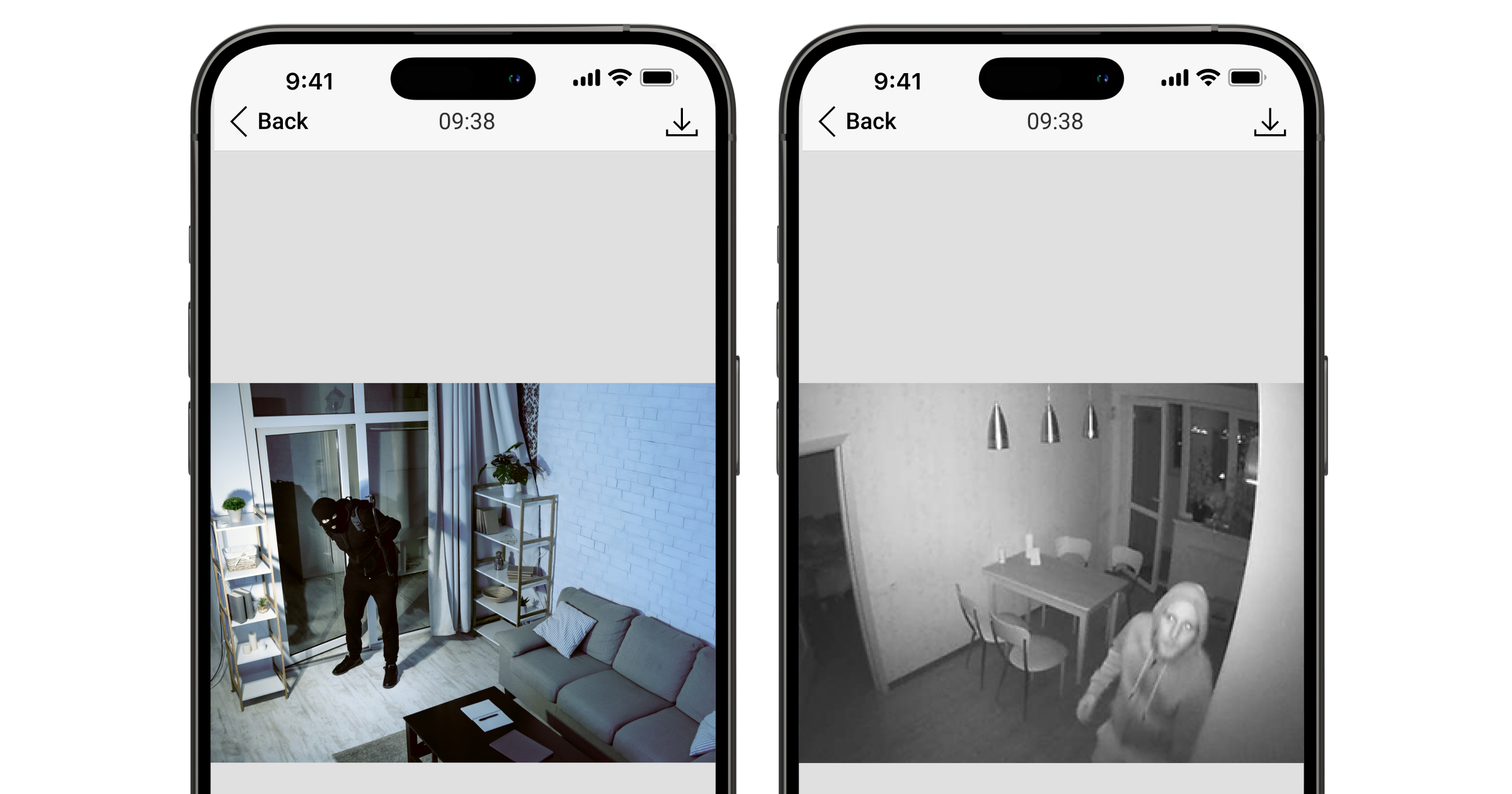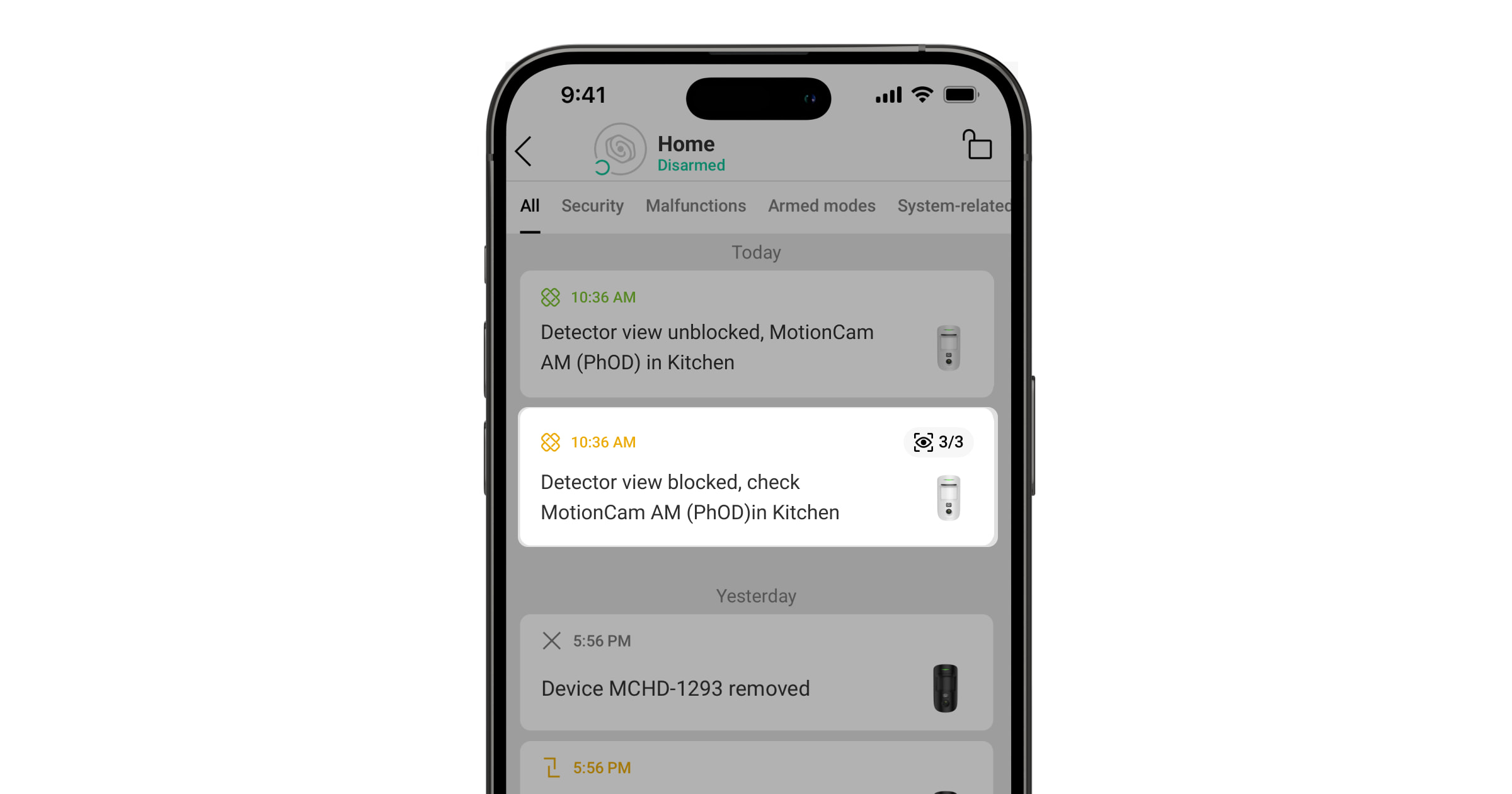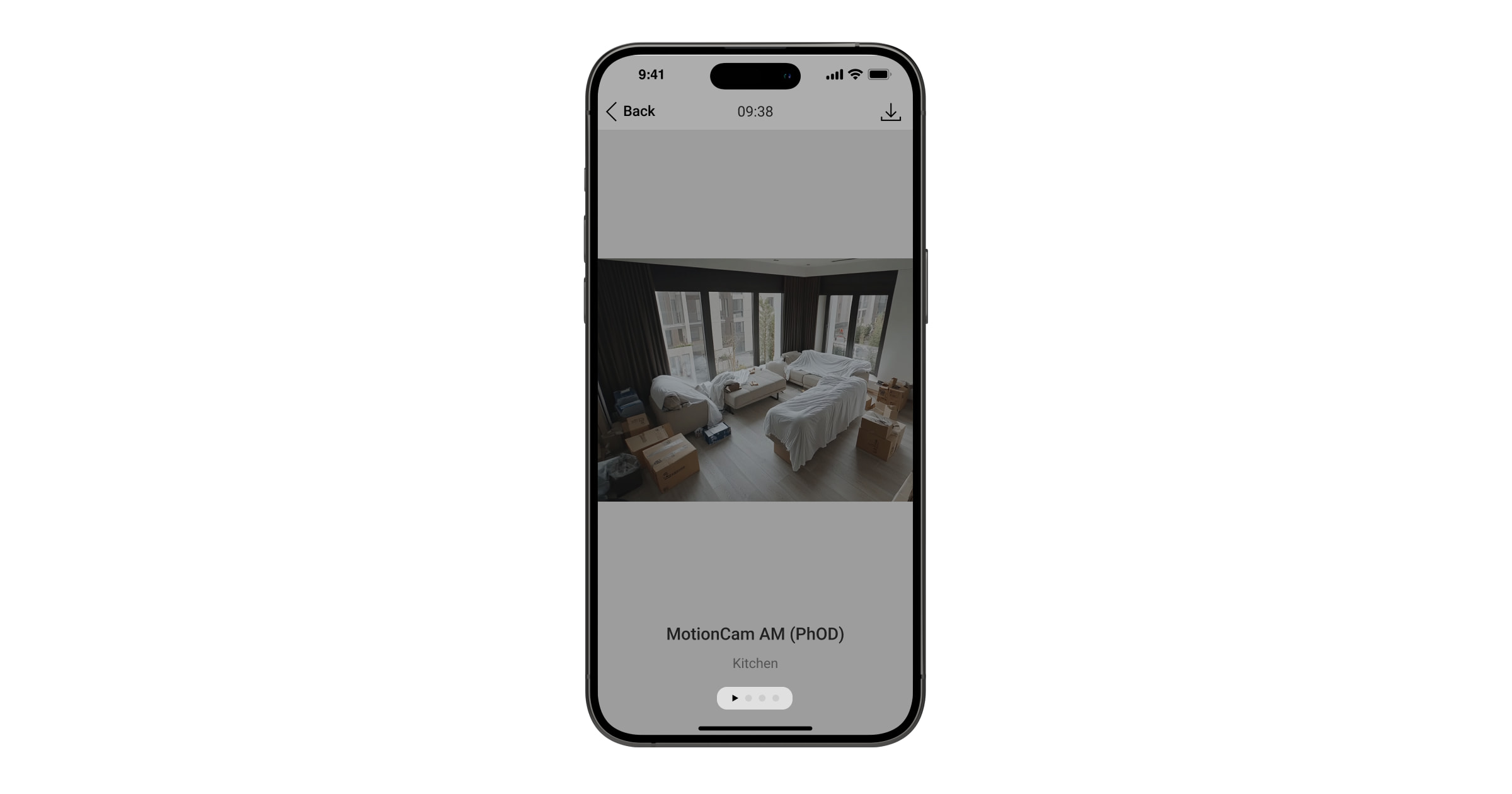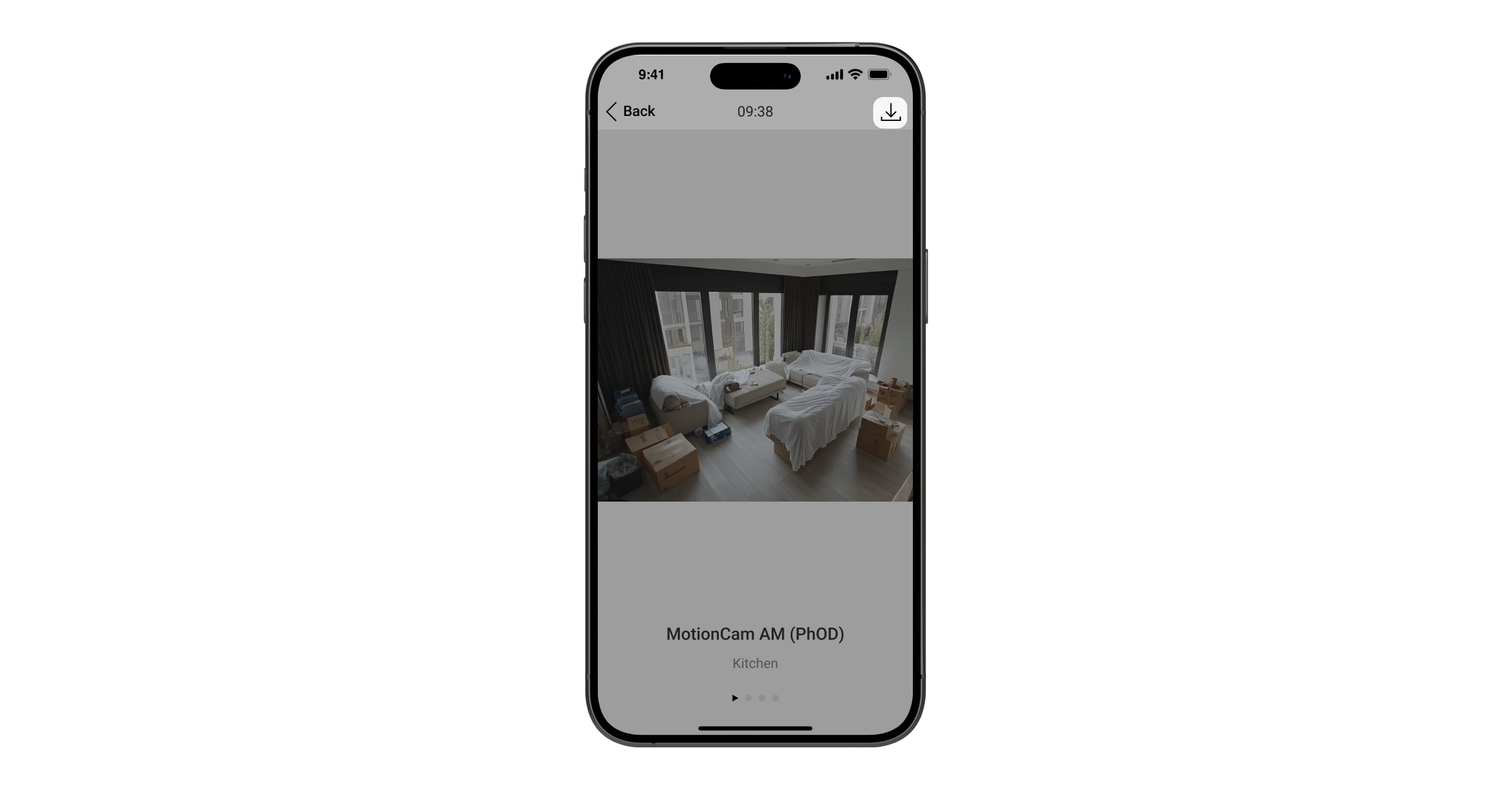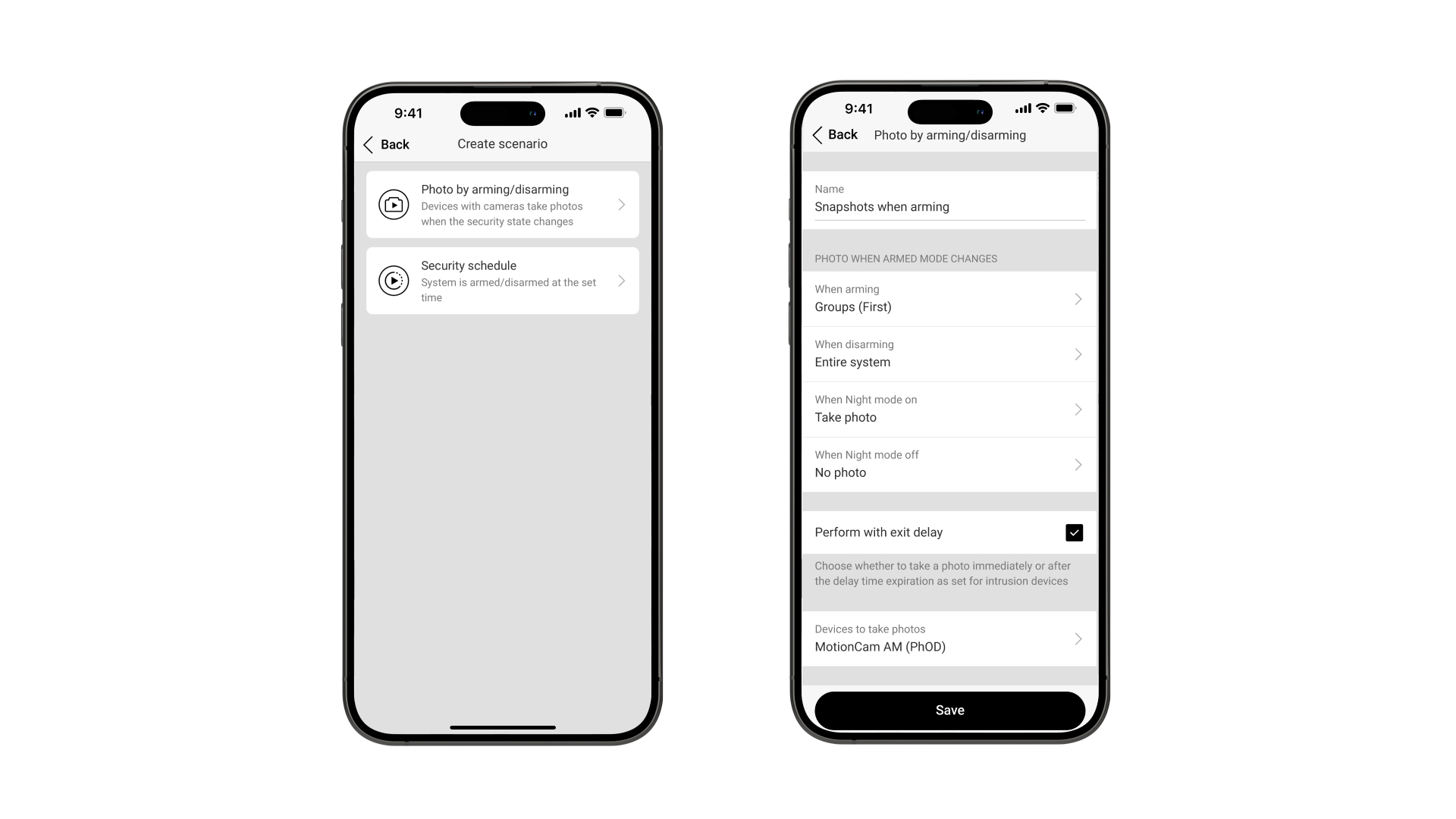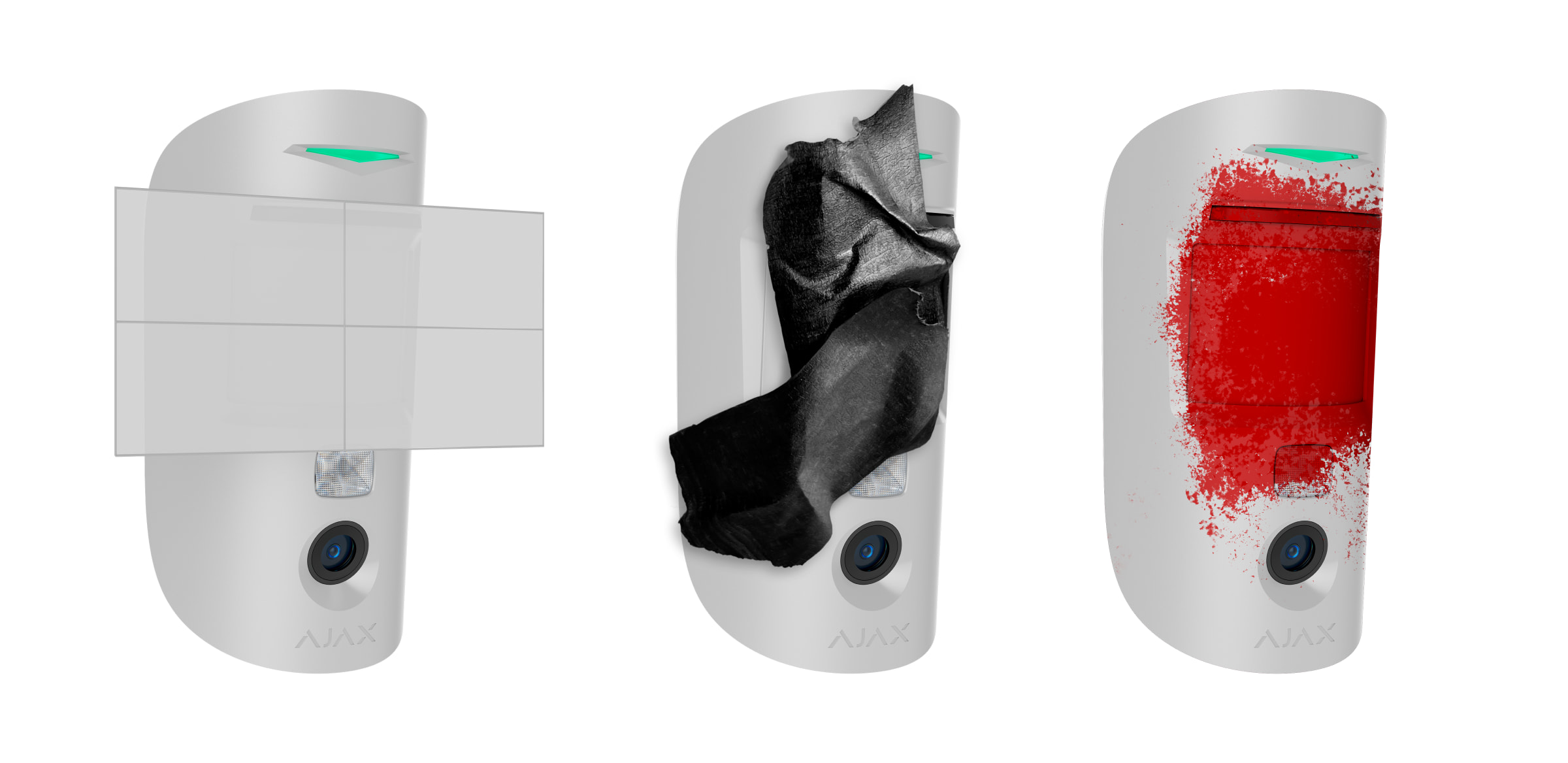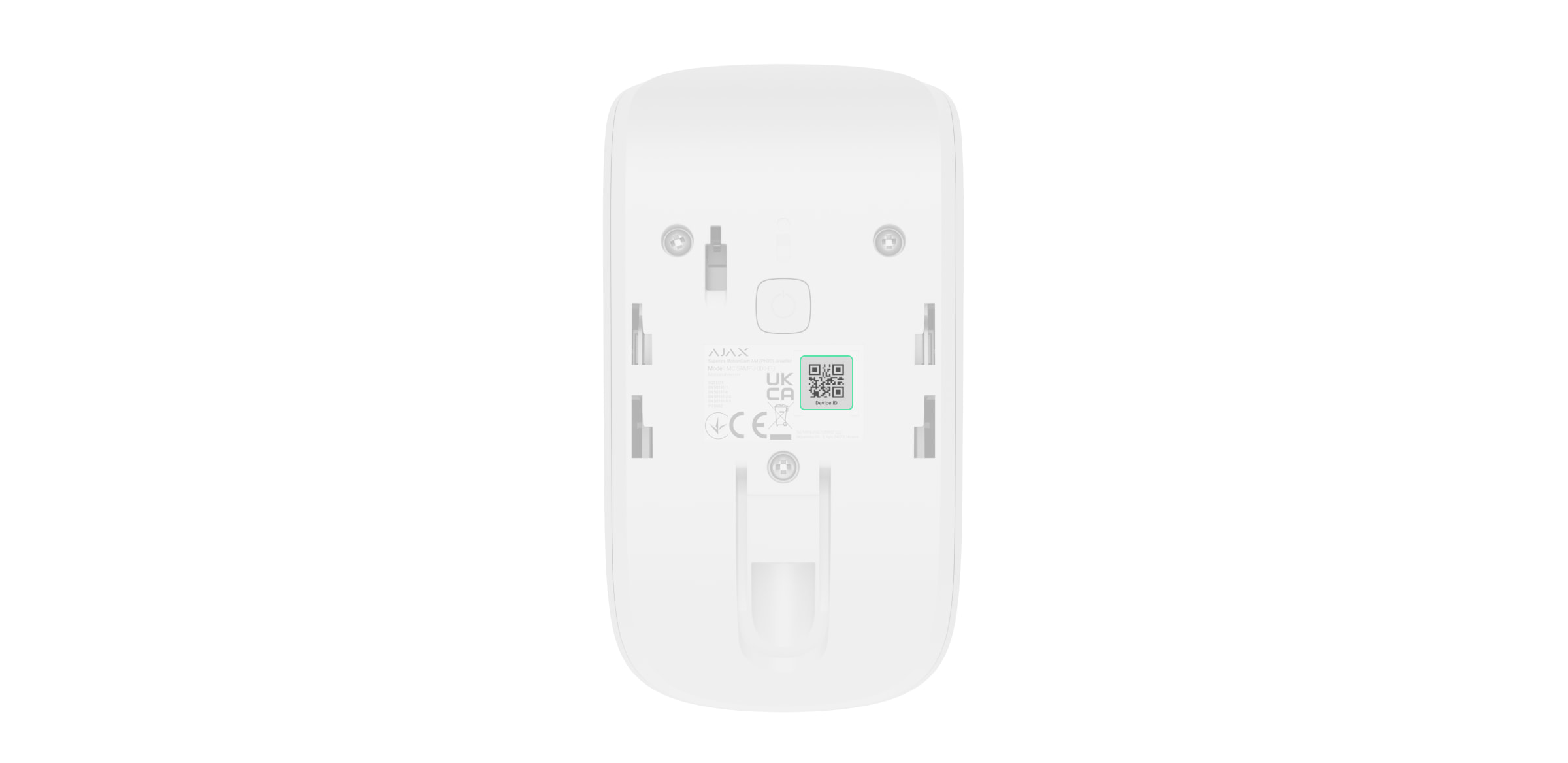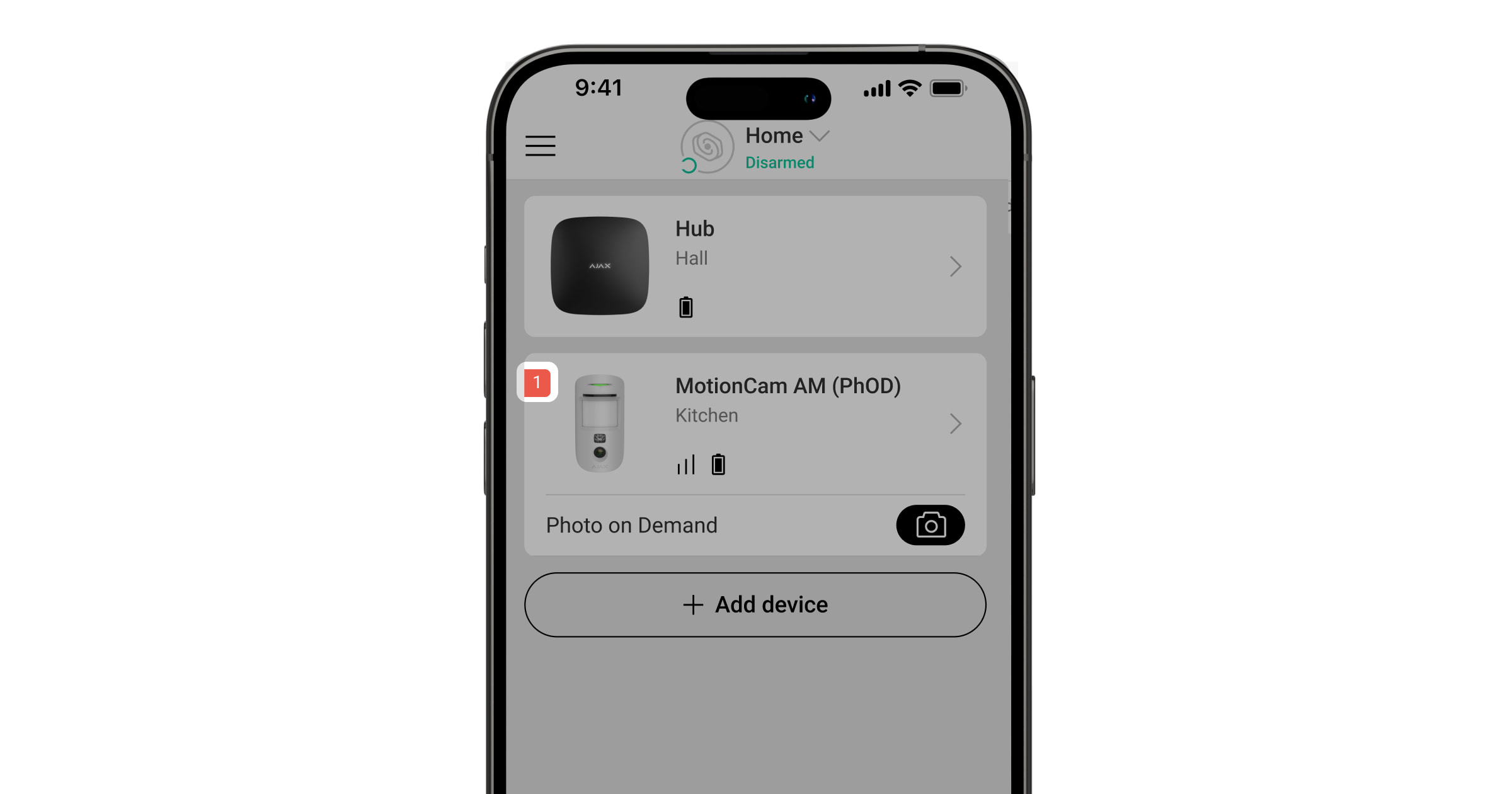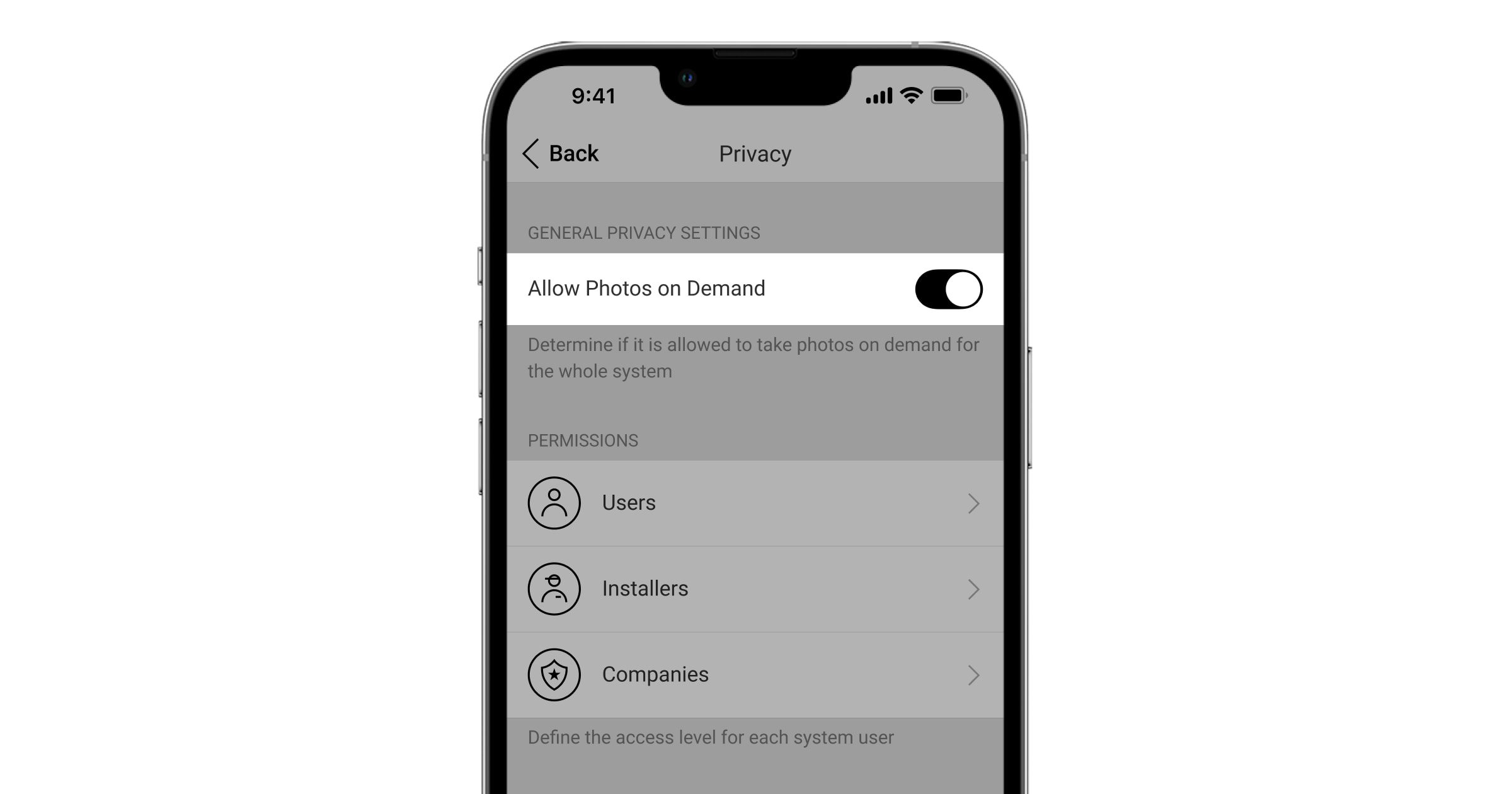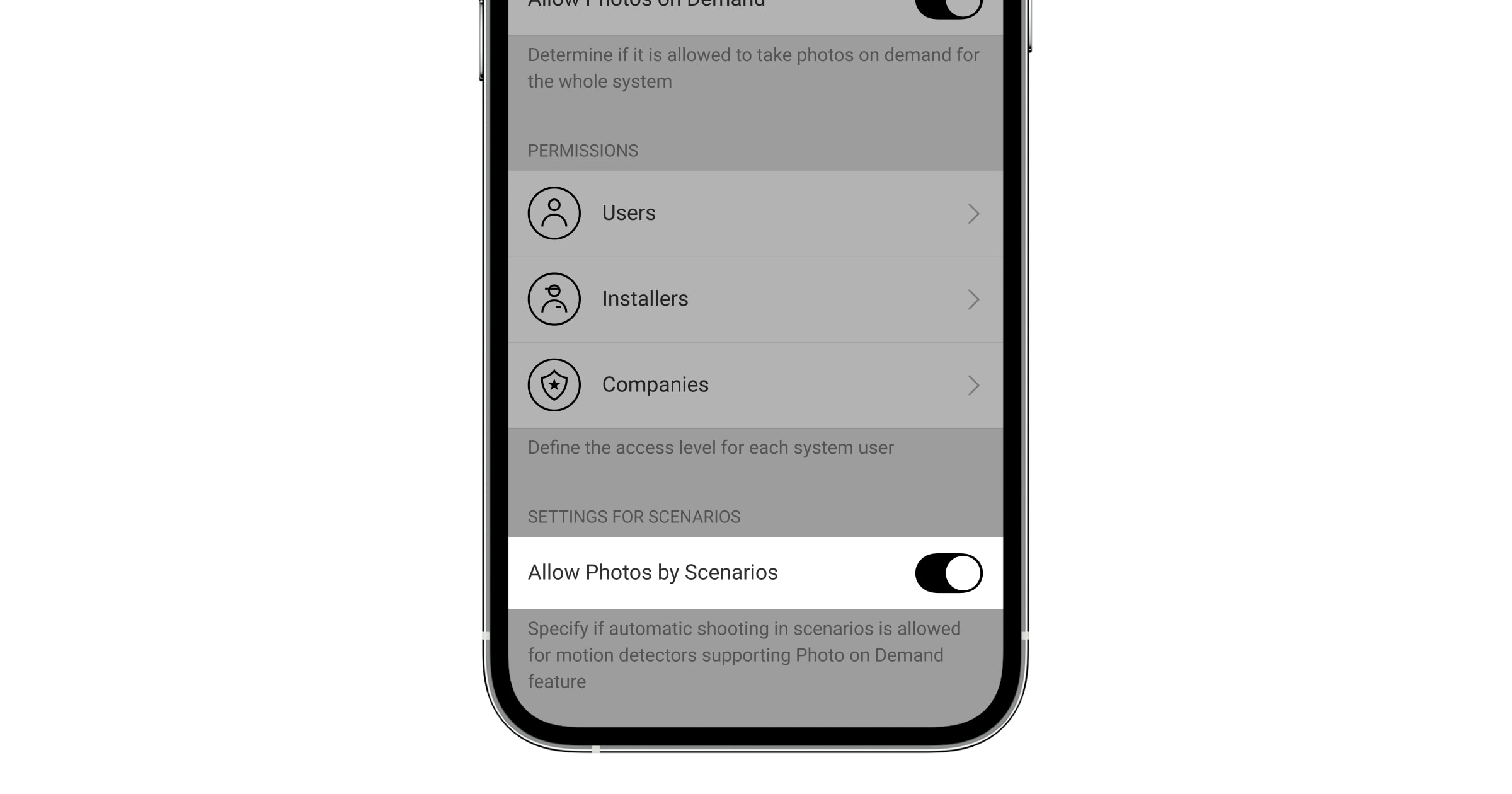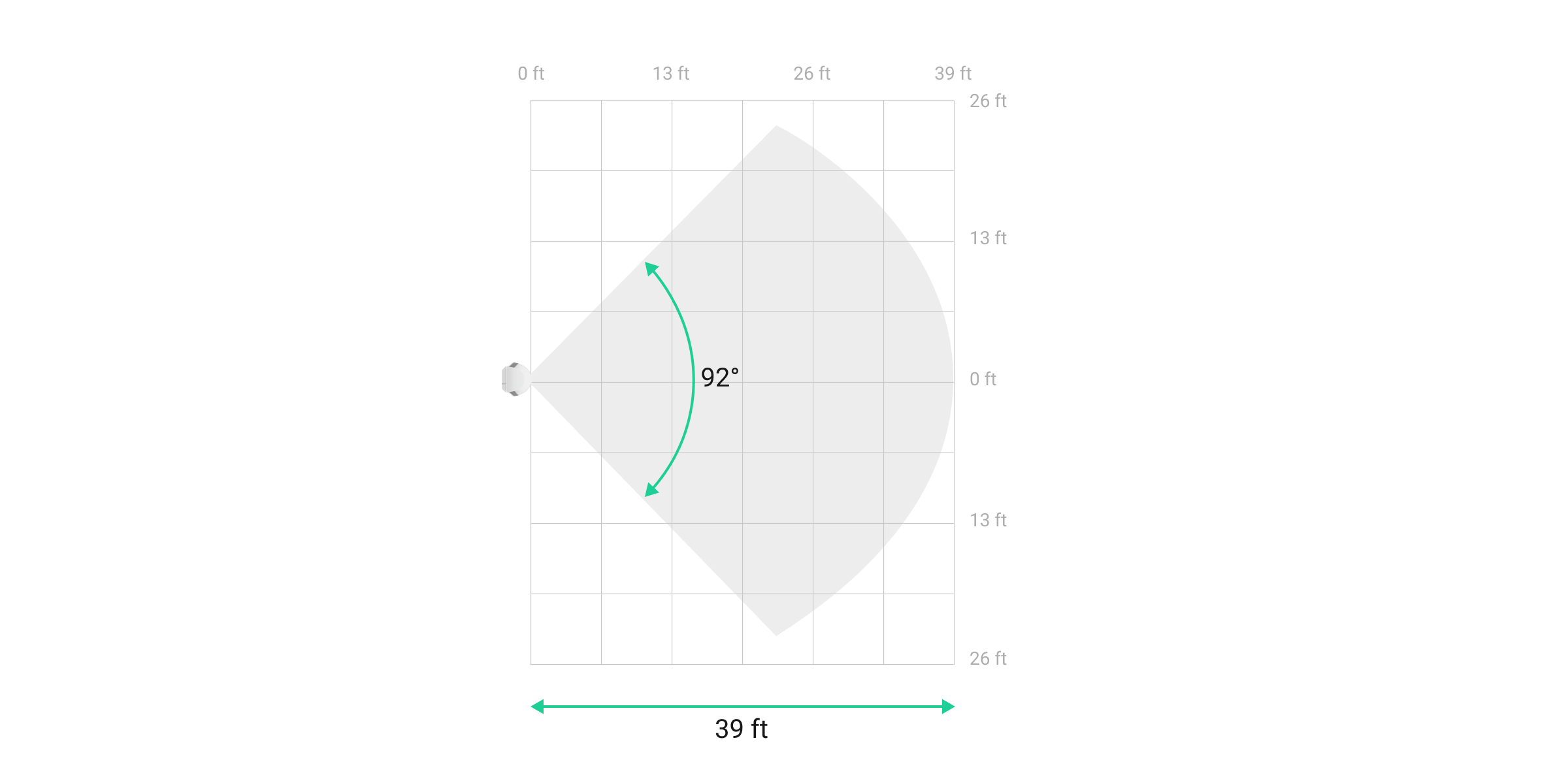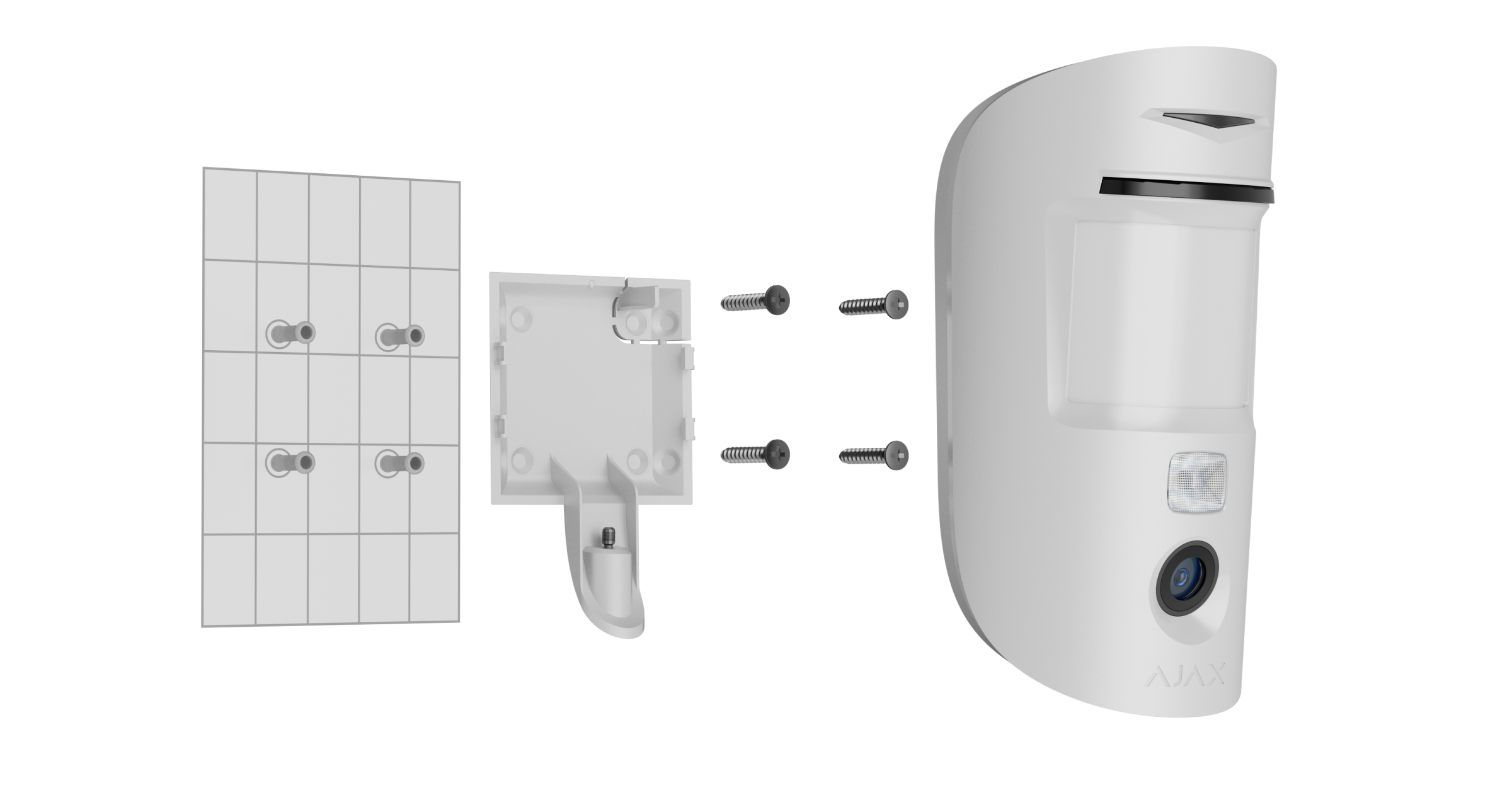Superior MotionCam AM (PhOD) Jeweller is a wireless IR motion detector that takes on-demand photos and photos by alarm, tamper alarm, masking, schedule, arming/disarming, or scenario. Superior edition. It is equipped with an anti-masking system and is intended for indoor installation. The device can detect movement at a distance of up to 39 ft.
Superior MotionCam AM (PhOD) Jeweller operates as part of an Ajax system and communicates with the hub via two secure radio protocols. The detector uses Jeweller to transmit alarms and events and Wings to transmit photos. The range of communication with the hub is up to 5,600 ft in an open space.
Functional elements
- LED indicator.
- Masking sensor.
- Motion detector lens.
- Infrared illumination. It is used to take photos in dark and low-light conditions.
- Camera.
- Perforated part of the mounting panel. It is required to trigger a tamper in case of any attempt to detach the detector from the surface. Do not break it off.
- SmartBracket mounting panel. To remove the panel, slide it down.
- Hole to secure the SmartBracket mounting panel with a holding screw.
- Tamper button. It is triggered when an attempt is made to detach the detector from the surface or remove it from the mounting panel.
- Power button of the detector.
- Detector QR code. It is used to add the detector to an Ajax system.
Compatible hubs and range extenders
Superior MotionCam AM (PhOD) Jeweller requires a hub to operate.
Connection to other hubs, radio signal range extenders, ocBridge Plus, and uartBridge are not provided.
Operating principle
Superior MotionCam AM (PhOD) Jeweller is a wireless motion detector supporting photo verification. It detects movement in the protected area with an infrared sensor by capturing moving objects with a temperature close to the human body. Additionally, this device features an anti-masking system. When movement or masking is detected, the built-in camera takes a series of photos. This allows you to dynamically assess what is happening at the site, saving users from unnecessary anxiety and security companies from false patrol dispatches.
When an armed detector identifies movement, it instantly sends an alarm to the hub, which activates the sirens connected to the system, triggers scenarios, and notifies users and the security company. If anti-masking is enabled, the system sends an alarm regardless of the security mode when masking is detected. All Superior MotionCam AM (PhOD) Jeweller alarms and events are recorded in the notification feed of an Ajax app.
Users know exactly where movement or masking is detected. The notifications contain the hub name (name of the secured facility), the name of the device, and the virtual room to which the detector is assigned.
Photo verification
Photo verification allows you to assess what is happening in the secured facility with a built-in camera. The device can take from 1 to 5 images with a resolution of 160 × 120 and 320 × 240 pixels and up to 3 images with a resolution of 640 × 480 and 960 × 720 pixels.
The HDR image feature improves the accuracy of detail in bright and dark scenes, allowing you to capture detailed images regardless of the lighting level. To do this, Superior MotionCam AM (PhOD) Jeweller takes two shots with different shutter speeds, and a special algorithm combines them to select the best combination of light and shadow.
With photo verification, you can receive visual confirmation of alarms from Superior MotionCam AM (PhOD) Jeweller and other Ajax devices. You can also check the situation: find out what the children are doing, check if your pet is OK, or simply monitor the situation at home.
For shooting in the dark, the detector has an infrared illumination that is activated in case of insufficient light. Superior MotionCam AM (PhOD) Jeweller takes grayscale photos when shooting in these conditions.
There are several types of photo verification, such as photo on demand, photos by alarm, tamper alarm, masking, schedule, arming/disarming, or scenario.
The photos can be displayed in the app as an image or animated series (if more than one photo is taken). The number of images in the series can be set up in Ajax apps. To view the received photos, tap on the corresponding Superior MotionCam AM (PhOD) Jeweller notification in the event feed.
Tap the icon at the bottom of the screen to view the images from the animated series frame by frame.
You can save the photo verification result as an animation or photo by tapping the download icon.
Photo by alarm
Superior MotionCam AM (PhOD) Jeweller alarms can be accompanied by an image or an animated series in Ajax apps. The detector takes photos by alarm only in armed mode.
By default, the Photo by alarm feature is enabled for all detectors. The first ten alarms are accompanied by an animated series of three images with a resolution of 640 × 480 pixels. The number of images and their resolution can be changed in the detector settings. Photos by alarm are available to all users with access to the event feed.
The detector does not switch to the armed mode instantly. The switching time depends on two factors, namely the delay when leaving (specified in the detector settings) and the hub–detector polling interval (hub settings, Jeweller section).
In the first case, the delay is set by an admin or a PRO user with system configuration rights. In the second case, the delay occurs because the hub takes one polling interval to notify the detector of the security mode change.
Photo by masking
The Take photo if masking detected feature allows users to receive photos from a built-in camera if masking is detected. This feature is enabled by default. Photo resolution and quantity of images depend on the settings selected for the Photo by alarm feature. If masking detection is enabled, photos by masking are available to all users with access to the event feed. If the feature is enabled, it is always active and works regardless of the security mode.
Photo by tamper alarm
The Take photo if lid opened feature allows users to receive photos from a built-in camera if the detector’s tamper is triggered. This feature is disabled by default. Photo resolution and quantity of images depend on the settings selected for the Photo by alarm feature. Photos by tamper alarm are available to all users with access to the event feed. If the feature is enabled, it is always active and works regardless of the security mode.
Photo on demand
The Photo on demand feature allows users to receive photos from the built-in cameras of detectors that support photo verification. With this feature, you can check the situation at the facility: find out what the children are doing, check if your pet is OK, or simply monitor the situation at home. Depending on the settings, photos can be taken at any time or when Superior MotionCam AM (PhOD) Jeweller is armed.
By default, the Photo on demand feature is disabled for all users. Users with the right to manage privacy settings (hub settings, Privacy section) determine who can take and view photos on demand and which detectors supporting photo verification can take photos. PRO users cannot manage privacy settings, but they can take photos on demand if they have been granted the permission.
Privacy settings do not apply to photos taken by detectors triggered in case of an alarm. All system users who have access to the hub event feed can view the photos taken in case of an alarm.
Photos on demand are not sent to the security company monitoring station.
PRO Desktop users can take and view photos on demand only from a personal account if a space admin has granted them the appropriate access rights. Taking and viewing photos on demand is not available for a security company profile in the PRO Desktop app.
Photo by scenario
The Photo by scenario feature allows you to create a scenario for motion detectors that support photo verification. These detectors will take photos in case of alarms from specified Ajax devices.
By default, the Allow photos by scenarios option is disabled for all detectors. A space admin or a user with access to privacy settings can enable it.
In the system settings, you can also set exactly when a detector supporting photo verification can take photos according to a scenario: always or when Superior MotionCam AM (PhOD) Jeweller is armed.
Photos by scenario are available to all system users with access to the event feed. The event of taking a photo after the alarm from specified devices is sent to the security company monitoring station via SIA DC-09 (SIA-DCS) and other proprietary protocols. The event code is 730.
If the CMS software supports photo verification, the CMS engineers can access photos by scenario. Photos by scenario are also available in the PRO Desktop app.
Photos by scenario will not be sent to the CMS if only a direct connection with the monitoring station is used.
Photo by schedule
The Photo by schedule feature allows you to create a scenario for motion detectors that support photo verification. These detectors will take photos by schedule.
Before creating a scheduled scenario, enable the Allow photos by scenarios option. A space admin or a user with access to privacy settings can enable this option.
You can precisely set when a detector that supports photo verification can take photos according to a scheduled scenario: always or when it is armed.
Photos by schedule are available to all system users with access to the event feed. The event of taking a photo is sent to the CMS via SIA DC-09 (SIA-DCS) and other proprietary protocols. The event code is 731.
If the CMS software supports photo verification, the CMS engineers can access photos by schedule. These photos are also available in PRO Desktop.
Photos by schedule will not be sent to the CMS if only a direct connection with the monitoring station is used.
Photo by arming/disarming
The Photo by arming/disarming feature allows users to receive photos from a built-in camera when the security state changes. With this feature, you can check the situation at the facility when the system is armed, disarmed, or switched to Night mode.
Before creating an arming/disarming scenario, enable the Allow photos by scenarios option. A space admin or a user with access to privacy settings can enable this option.
The Photo by arming/disarming scenario is available in the hub’s settings with OS Malevich 2.29 and later. The feature allows you to configure conditions under which the selected detectors take photos: when arming, when disarming, when Night mode is enabled, or when Night mode is disabled. Also, you can set up whether to consider or ignore entry/exit delays.
Photos by arming/disarming are available to all system users with access to the event feed. The event of taking a photo is sent to the CMS via SIA DC-09 (SIA-DCS) and other proprietary protocols. The event code is 732.
If the CMS software supports photo verification, the CMS engineers can access photos by arming/disarming. These photos are also available in PRO Desktop.
Photos by arming/disarming will not be sent to the CMS if only a direct connection with the monitoring station is used.
Jeweller and Wings data transfer protocols
Jeweller and Wings are wireless data transfer protocols that provide fast and reliable two-way communication between the hub and devices. The detector uses Jeweller to transmit alarms and events and Wings to transmit photos.
Photo delivery time
The time the detector takes to deliver photos to Ajax apps depends on the selected resolution, the detector connection to the radio signal range extender, the Wings signal strength, and the internet connection speed. Alarm notifications are delivered instantly.
| Photo resolution | Delivery time¹ |
| 160 × 120 pixels | up to 3 seconds |
| 320 × 240 pixels (by default) |
up to 4,5 seconds |
| 640 × 480 pixels | up to 11 seconds |
| 960 × 720 pixels | up to 15,5 seconds |
¹ When the detector is connected directly to the hub (without radio signal range extender ReX 2 Jeweller). The detector needs up to 3 seconds to start the Photo on demand shooting.
Temperature compensation
The detector perceives people and other objects as heat spots. The device monitors these heat spots and detects an alarm if they move. Under ideal conditions, the human body temperature (97.8 °F on average) differs from the ambient temperature, and their contrast allows the motion detector to detect human movement accurately.
When the ambient temperature is very close to the human body temperature, the detector may not operate properly and may activate false alarms. Temperature compensation is used in all Ajax motion detectors, so Superior MotionCam AM (PhOD) Jeweller detects movement within the entire operating temperature range.
Pet immunity
Superior MotionCam AM (PhOD) Jeweller does not support the Pet immunity feature.
Anti-masking system
Masking is an attempt to block the view of the detector by painting over it, covering it, placing an obstacle in front of the detector lens, or otherwise.
A user can adjust the Masking sensor sensitivity in the detector settings.
Superior MotionCam AM (PhOD) Jeweller detects the following types of masking:
- Placing an obstacle in front of the detector lens at a distance of up to 20″ (the maximum distance depends on the type of material).
- Painting over the lens with colored paint.
- Sticking over the front part of the detector with an opaque material.
If the Anti-masking feature is enabled, it is always active and works regardless of the security mode.
| Masking type | Detector is armed | Detector is disarmed | ||
| Time to alarm, s | Time to restore, s | Time to alarm, s | Time to restore, s | |
| Placing an obstacle in front of the lens | <24 |
<30 |
<40 |
<50 |
| Sticking or painting over the lens | <24 |
<30 |
<40 |
<50 |
| Sticking over the front part of the detector | <24 |
<30 |
<40 |
<50 |
| Painting over the front part of the detector | <24 |
<30 |
<40 |
<50 |
When masking is detected, the detector raises an alarm. The detector’s LED lights up green for 1 s. The system informs the users and the security company of masking. You can enable the siren response to masking in the detector settings for additional protection and information.
Sending events to the monitoring station
An Ajax system can transmit alarms to the PRO Desktop monitoring app and the central monitoring station (CMS) in the formats of SurGard (Contact ID), SIA DC-09 (SIA-DCS), ADEMCO 685, and other proprietary protocols.
Superior MotionCam AM (PhOD) Jeweller can transmit the following events:
- Motion alarm.
- Masking alarm.
- Visual alarm verifications.
- Photos by scenario.
- Photos by schedule.
- Photos by arming/disarming.
- Tamper alarm/recovery.
- Loss/restoration of connection with the hub.
- Deactivation/activation of the detector.
- Unsuccessful attempt to arm the security system (if the system integrity check is enabled).
Photos on demand are not sent to the security company monitoring station.
PRO Desktop users can take and view photos on demand only from a personal account if a space admin has granted them the appropriate access rights. Taking and viewing photos on demand is not available for a security company profile in the PRO Desktop app.
When an alarm is received, the operator of the security company monitoring station knows exactly what happened and where to send the rapid response unit. The addressability of each Ajax device allows you to send not only events to PRO Desktop or CMS but also the type of the device, its name, and the virtual room to which the detector is assigned. Note that the list of transmitted parameters may differ depending on the type of CMS and the selected protocol for communication with the monitoring station.
The ID and the number of the device can be found in its states in an Ajax app.
Photos are sent to the security company monitoring station if the CMS software supports photo verification. A list of such CMSs is available here. At the same time, PRO Desktop supports receiving photo verification without additional setup.
Adding to the system
Before adding a device
- Install an Ajax PRO app.
- Log in to a PRO account or create a new one.
- Select a space or create a new one.
- Add at least one virtual room.
- Add a compatible hub to the space. Ensure the hub is switched on and has internet access via Ethernet, Wi-Fi, and/or mobile network.
- Check the states in an Ajax app to ensure the space is disarmed and the hub is not starting an update.
How to add Superior MotionCam AM (PhOD) Jeweller
Only a user or a PRO with admin rights can add Superior MotionCam AM (PhOD) Jeweller to the hub.
- Open an Ajax app. If your account has access to multiple hubs or if you use the PRO app, select the hub to which you want to add Superior MotionCam AM (PhOD) Jeweller.
- Go to the Devices
tab and tap Add device.
- Scan the QR code or type in the device ID (placed on the detector enclosure and the package box), name the detector, and select a room and a group (if Group mode is enabled).
- Tap Add.
- Switch on the device by holding the power button for 3 seconds.
To add Superior MotionCam AM (PhOD) Jeweller to the hub, place the detector at the same secured facility as the system (within the coverage of the hub radio network). For the detector to operate via the ReX 2 radio signal range extender, you must first add the detector to the hub and then connect it to ReX 2 in the range extender settings.
The detector added to the hub will appear in the list of hub devices in the Ajax app. Updating the states of devices in the list depends on the Jeweller (or Jeweller/Fibra) settings; the default value is 36 seconds.
If the connection fails, turn the detector off and try again in 5 seconds. Note that if the maximum number of devices has already been added to the hub (depending on the hub model), you will be notified when you try to add a new one.
The hub and the device operating at different radio frequencies are incompatible. The device radio frequency band may vary by region. We recommend purchasing and using Ajax devices in the same region. You can contact Ajax Technical Support to check the radio frequency bands in your region.
Superior MotionCam AM (PhOD) Jeweller only works with one hub. When connected to a new hub, the detector stops sending commands to the old one. When added to a new hub, the detector is not removed from the device list of the old hub. This must be done through an Ajax app.
Malfunctions
When a malfunction is detected (for example, there is no connection via Jeweller), an Ajax app displays a malfunction counter on the device icon.
All malfunctions are shown in the detector states. Fields with malfunctions will be highlighted in red.
A malfunction is displayed if:
- The detector temperature is outside the permissible limits: below 14 °F and above 104 °F.
- The detector enclosure is open (tamper is triggered).
- There is no connection with the hub or radio signal range extender via Jeweller.
- There is no connection with the hub or radio signal range extender via Wings.
- The detector battery is low.
Icons
The icons display some of Superior MotionCam AM (PhOD) Jeweller states. You can view them in an Ajax app in the Devices tab.
| Icon | Meaning |
|
Jeweller signal strength. Displays the signal strength between the hub and the detector. The recommended value is 2–3 bars. |
|
|
Battery charge level of the detector. |
|
| The icon is displayed if more than one user has access to the camera. | |
| The icon is displayed when the detector is operating via a radio signal range extender. | |
|
The detector operates in the Always active mode. |
|
|
Delay when entering and/or leaving is enabled. |
|
|
Superior MotionCam AM (PhOD) Jeweller will be armed when Night mode is enabled. |
|
|
The device is in the signal attenuation test mode. |
|
| Masking is detected. | |
|
Superior MotionCam AM (PhOD) Jeweller is deactivated. |
|
|
The device is deactivated until the system is disarmed for the first time. |
|
|
Superior MotionCam AM (PhOD) Jeweller is deactivated because the preset number of alarms has been exceeded. |
|
|
Events of tamper triggering are deactivated. |
|
|
Tamper alarm notifications are deactivated until the system is disarmed for the first time. |
|
| The device has lost connection with the hub or the hub has lost connection with the Ajax Cloud server. | |
|
The device has not been transferred to the new hub. |
States
The states include information about the device and its operating parameters. The states of Superior MotionCam AM (PhOD) Jeweller can be found in Ajax apps:
- Go to the Devices
tab.
- Select Superior MotionCam AM (PhOD) Jeweller from the list.
| Parameter | Meaning |
| Data import | Displays the error when transferring data to the new hub:
|
| Malfunction |
Tapping on The field is displayed if a malfunction is detected. |
| Temperature |
Device temperature. It is measured by Superior MotionCam AM (PhOD) Jeweller and changes depending on the ambient temperature. You can create a scenario by temperature to control automation devices. |
| Jeweller signal strength |
Signal strength between the hub (or the range extender) and the detector via the Jeweller channel. The recommended value is 2–3 bars. Jeweller is a protocol for transmitting Superior MotionCam AM (PhOD) Jeweller events and alarms. |
| Connection via Jeweller | Connection status via the Jeweller channel between the hub (or the range extender) and the detector:
|
| Wings signal strength |
Signal strength between the hub (or the range extender) and the detector via the Wings channel. The recommended value is 2–3 bars. Wings is a protocol for transmitting Superior MotionCam AM (PhOD) Jeweller photo verifications. |
| Connection via Wings | Connection status via the Wings channel between the hub (or the range extender) and the detector:
|
| Transmitter power |
Displays the selected power of the transmitter. The parameter appears when the Max or Attenuation option is selected in the Signal attenuation test menu. |
| Battery charge | The battery charge level of the device:
When the batteries are low, users and the security company will receive appropriate notifications. After sending the notification, the detector can operate for up to 2 months. |
| Lid | The state of the detector tamper that responds to detachment or opening of the device enclosure:
|
| Sensitivity | Shows the sensitivity level of the motion detector:
|
| Anti-masking | The state of the masking sensor:
|
| Masking sensor sensitivity | The state of the masking sensor’s sensitivity:
Displayed if Anti-masking is On. |
| Always active |
When this option is enabled, the detector is constantly armed, detects movement, and raises alarms. |
| Permanent deactivation | Shows the state of the device’s permanent deactivation setting:
|
| One-time deactivation | Shows the state of the device’s one-time deactivation setting:
|
| Photo on demand access |
The state is displayed if Photo on demand is enabled in the hub settings in the Privacy section. |
| Alarm reaction | |
| Operating mode | Shows how the detector responds to alarms:
|
| Delay when entering, sec |
Delay when entering: from 5 to 255 seconds. Delay when entering (alarm activation delay) is the time the user has to disarm the security system after entering the secured area. |
| Delay when leaving, sec |
Delay when leaving: from 5 to 255 seconds. Delay when leaving (arming delay) is the time the user has to leave the secured area after the security system is armed. |
| Arm in Night mode |
When this option is enabled, the device will enter the armed mode if the system is set to Night mode. |
| Night mode delay when entering, sec |
Entry delay time in Night mode. Delay when entering (alarm activation delay) is the time the user has to disarm the security system after entering the premises. |
| Night mode delay when leaving, sec |
Leaving delay time in Night mode. Delay when leaving (arming delay) is the time the user has to leave the premises after enabling Night mode. |
| Firmware | Detector firmware version. |
| ID | Detector ID. It is also available on the QR code on the detector enclosure and its package box. |
| Device No. | Number of the device loop (zone). |
Settings
To change Superior MotionCam AM (PhOD) Jeweller settings in Ajax apps:
- Go to the Devices
tab.
- Select Superior MotionCam AM (PhOD) Jeweller from the list.
- Go to Settings by tapping on the gear
icon.
- Set the required parameters.
- Tap Back to save the new settings.
| Settings | Meaning |
| Name |
Name of the detector. It is displayed in the list of hub devices, text of SMS and notifications in the event feed. To change the name of the detector, tap on the text field. The name can contain up to 12 Cyrillic characters or up to 24 Latin characters. |
| Room |
The virtual room to which Superior MotionCam AM (PhOD) Jeweller is assigned. The name of the room is displayed in the text of SMS and notifications in the event feed. |
| Alarm LED indication | When the option is disabled, the LED indicator of the detector does not notify of alarms or tamper triggering. |
| Sensitivity |
Sensitivity level of the motion detector. It depends on the facility type, the presence of probable sources of false alarms, and the specifics of the secured area:
|
| Anti-masking | When this option is enabled, the device detects masking. |
| Masking sensor sensitivity | Sensitivity level depends on the device installation site and can be:
A higher level of sensitivity increases the masking detection range. |
| Take photo if masking detected | When this option is enabled, the device will take a photo if masking is detected. |
| Take photo if lid opened | When this option is enabled, the device will take a photo if the tamper is triggered. |
| Image resolution | The image resolution (in pixels):
The higher the resolution, the more detailed the image is, but it takes longer to transfer the photos. The setting extends to visual alarm verification, photo on demand, photos by alarm, tamper alarm, masking, schedule, arming/disarming, or scenario. |
| Photos by alarm | The number of photos in case of an alarm:
The setting applies to photos by alarm, by tamper alarm, or by masking alarm. |
| Alarms with photo verification |
The number of alarms accompanied by photos. You can specify 1 to 10 alarms or set up the transmission of a photo each time the device is triggered. An alarm counter with photo verification is reset when the security system is disarmed and rearmed. The setting is available if the Always active option is disabled. When the detector is in the Always active mode, it will transmit a photo every time it is triggered. |
| Photos on demand | The number of photos on demand:
|
| Always active |
When this option is enabled, the detector is always in armed mode and detects movement. |
| HDR image | When this option is enabled, the device improves detail accuracy in bright and dark scenes. |
|
Alert with siren |
|
| If motion detected | When this option is enabled, the sirens added to the system are activated when Superior MotionCam AM (PhOD) Jeweller detects movement. |
| If masking detected | When this option is enabled, the sirens added to the system are activated when Superior MotionCam AM (PhOD) Jeweller detects masking. |
| Scenarios |
This setting opens the menu for creating and configuring scenarios for the Superior MotionCam AM (PhOD) Jeweller detector. The menu allows you to create a scenario according to which the detector takes photos by schedule or when specified Ajax devices are triggered. |
|
Alarm reaction |
|
| Operating mode | With this setting, you can specify how the device will respond to alarms:
|
| Delay when entering, sec |
Delay when entering: from 5 to 255 seconds. Delay when entering (alarm activation delay) is the time the user has to disarm the security system after entering the secured area. |
| Delay when leaving, sec |
Delay when leaving: from 5 to 255 seconds. Delay when leaving (arming delay) is the time the user has to leave the secured area after the security system is armed. |
| Arm in Night mode |
When this option is enabled, the detector will enter the armed mode if the system is set to Night mode. |
| Night mode delay when entering, sec |
Delay when entering in Night mode: from 5 to 255 seconds. Delay when entering (alarm activation delay) is the time the user has to disable Night mode after entering the premises. |
| Night mode delay when leaving, sec |
Delay when leaving in Night mode: from 5 to 255 seconds. Delay when leaving (arming delay) is the time the user has to leave the premises after enabling Night mode. |
| Jeweller signal strength test |
Switches the detector to the Jeweller signal strength test mode. The test allows you to check the signal strength between the hub (or the range extender) and the detector via the Jeweller wireless data transfer protocol to select the optimal installation location. |
| Wings signal strength test |
Switches the detector to the Wings signal strength test mode. The test allows you to check the signal strength between the hub (or the range extender) and the detector via the Wings wireless data transfer protocol to select the optimal installation location. |
| Detection zone test |
Switches the detector to the detection zone test mode. The test enables users to check how the detector responds to movement and select the optimal installation location. |
| Signal attenuation test |
Switches the device to the signal attenuation test mode. During the test, the transmitter power is decreased or increased to simulate environmental changes. This is required to test the stability of communication between the detector and the hub. |
| User guide | Opens the Superior MotionCam AM (PhOD) Jeweller user manual in an Ajax app. |
| Permanent deactivation |
Allows a user to disable the device without removing it from the system. Three options are available:
The system can also automatically deactivate devices when the preset number of alarms is exceeded. |
| One-time deactivation |
Allows a user to disable events of the device until the system is disarmed for the first time. Three options are available:
|
| Delete device | Unpairs the detector, disconnects it from the hub, and deletes its settings. |
Masking sensor calibration
Calibration of a masking sensor is important to ensure the device operates correctly and can instantly detect attempts to block its sensors’ field of view. The masking sensor is calibrated automatically when the detector is added to the system, anti-masking settings are changed, or the detector is removed from the SmartBracket mounting panel and installed back. If the device fails to calibrate the masking sensor, the system sends a notification to users and the CMS and displays the corresponding fault in the device states.
Configuring the Photo on demand feature
A space admin or a user with access to privacy settings can enable and configure the Photos on demand feature. To do this, in an Ajax app:
- Select the space if you have more than one.
- Go to the Control
tab.
- Tap on the gear
icon to go to the space Settings.
- Select the Privacy menu and enable the Allow photos on demand option.
- Select the user category:
- Users
- Installers
- Companies
- Select a specific user, PRO, or a company. A list of cameras, DVRs, and detectors supporting photo verification added to the space will open.
- Select the detector to which you want to provide access.
- Enable the Take & view photos option.
- Specify when the user can take on-demand photos: Always or When device armed.
- Tap on Back to save the settings.
After saving the privacy settings, all users with access to the event feed will receive a notification of who has received access rights and which user has granted these rights.
Configuring the Photo by scenario feature
How to enable Photo by scenario
A space admin or a user with access to privacy settings can enable the Photo by scenario feature. To do this, in an Ajax app:
- Select the space if you have more than one.
- Go to the Control
tab.
- Tap on the gear
icon to go to the space Settings.
- Select the Privacy menu and enable the Allow photos by scenarios option.
- Tap on Back to save the settings.
How to create a scenario for taking photos in case of alarms from specified devices
A space admin or a PRO with system configuration rights can create and set up a scenario. To do this:
- In an Ajax app, select the space if you have several or if you use the PRO app.
- Go to the Devices
tab and select a detector supporting photo verification.
- Tap on the gear
icon to go to the detector Settings.
- Select the Scenarios item from the list.
- Select Ajax devices and alarm types that will trigger photo verification.
- Tap on Next.
- Specify:
- Name of the scenario.
- Number of devices that trigger a scenario (available if there are two or more Ajax devices in the system):
Any — the scenario will run if at least one device is triggered.
All selected — the scenario will run if all selected devices are triggered. - Triggering time for all devices (the setting is available if the All selected option is specified in the Devices triggering the scenario block).
To run the scenario, all selected devices should raise the alarm within the specified time. If the devices do not raise the alarm within the specified time, the timer will reset, and the scenario will not run.
- When the detector can take photos: Always or When armed. By default, Superior MotionCam AM (PhOD) Jeweller takes photos by scenario only in the armed mode.
Note that only the space admin can specify when the detector should take photos.
- Tap on Save. The scenario will appear in the list of device scenarios.
The scenario will not be executed if the Allow photos by scenarios option is disabled in the privacy settings (hub settings, Privacy menu).
To delete or edit a scenario, tap on it in the list. You can also disable the scenario with a toggle next to the scenario name: its settings will be saved but not executed after the alarm from other devices.
Permanently disabled (PhOD) detectors cannot take photos by scenario and do not run the scenario for taking photos.
Configuring the Photo by schedule feature
A space admin or PRO with system configuration rights can create and set up a scenario by schedule. To do this:
- Open an Ajax app and select the space if you have several or if you use the Ajax PRO app.
- Go to the Devices
tab and select a detector supporting photo verification.
- Tap on the gear
icon to go to the detector Settings.
- Select the Scenarios item from the list.
- Select the By schedule scenario type.
- Specify:
- Name of the scenario.
- Device action — only Take photo by default. The quantity of photos equals the quantity of Photos on demand specified in the settings.
- Execution time — 24h or 12h format, depending on the device time format. Tap on the field to set the defined time for the detector.
- Repeat — tap on the field to set the day of the week.
- When the detector can take photos: Always or When armed. By default, Superior MotionCam AM (PhOD) Jeweller takes photos by schedule only in the armed mode.
Note that only a space admin can specify when the detector should take photos.
- Tap on Save. The scenario will appear in the list of device scenarios.
Indication
The Superior MotionCam AM (PhOD) Jeweller LED indicator can light up red or green, depending on the detector’s state.
Indication upon pressing the power button
| Indication | Event |
| Lights up green. | Turning the detector on. |
| Lights up red and then flashes three times. | Turning the detector off. |
Enabled detector indication
| Indication | Event | Note |
| Lights up green for 1 second. | Motion alarm / tamper alarm / masking is detected. | The device detects movement every 7 seconds. |
| Lights up green for 1 second. | Photos on demand / by scenario are being taken. | When photos on demand or by scenario are taken, the indicator lights up even if the LED indication is turned off in the detector settings. |
| Lights up green for a few seconds. | The detector is being added to the hub. | |
| Lights up red and flashes after the first activation. | Hardware error. | The detector needs to be repaired, please contact our Technical Support. |
| In case of an alarm, it slowly lights up green and goes out. | Detector batteries need to be replaced. | The procedure for replacing the batteries is described in the article. |
| Flashes green frequently. | The batteries are completely discharged. The detector stopped detecting movement and transmitting alarms to the hub. | The procedure for replacing the batteries is described in the article. |
| Flashes green frequently from 5 to 20 seconds. | The detector is calibrating the anti-masking system. | After the anti-masking sensitivity has been changed, the indicator flashes for 5 seconds. When the detector is turned on and installed on SmartBracket, it starts the anti-masking calibration automatically, and the indicator flashes for 15 seconds. When both conditions are met, the indicator flashes for 20 seconds. |
| Lights up red for 1 second every 12 seconds. | Masking sensor calibration error. | Remove the detector from the SmartBracket mounting panel and install it again to initiate the masking sensor calibration. For proper calibration, ensure that there are no obstacles in front of the detector and that it is not moved. |
Functionality testing
An Ajax system provides several types of tests to ensure that the installation place is chosen correctly. Superior MotionCam AM (PhOD) Jeweller tests do not start immediately but not later than after one hub–detector polling interval (36 seconds by default). You can change the polling interval in the Jeweller menu of the hub settings.
To run a test, in an Ajax app:
- Select the required space.
- Go to the Devices
tab.
- Select Superior MotionCam AM (PhOD) Jeweller from the list.
- Go to Settings
.
- Select a test:
- Run the test.
Detector placement
The device is designed for indoor use only.
When choosing where to place Superior MotionCam AM (PhOD) Jeweller, consider the parameters that affect its operation:
- Motion detection zone.
- The camera viewing angle and obstacles in front of it.
- The masking sensor viewing angle and the presence of obstacles in front of it.
- Jeweller and Wings signal strength.
- Distance between the detector and the hub.
- Obstacles in the path of the radio signal, such as walls, interfloor ceilings, or large objects located on the premises.
Consider the recommendations for placement when designing the security system. Only specialists should design and install it. A list of recommended partners is available here.
Signal strength
The Jeweller and Wings signal strength is determined by the number of undelivered or corrupted data packages over a certain period of time. The icon on the Devices
tab indicates the signal strength:
- Three bars — excellent signal strength.
- Two bars — good signal strength.
- One bar — low signal strength, stable operation is not guaranteed.
- Crossed-out icon — no signal.
Check the Jeweller and Wings signal strength before final installation. With a signal strength of one or zero bars, we do not guarantee the device will operate properly. Consider relocating the device, as repositioning even by 7.8” can significantly improve the signal strength. If the signal remains poor or unstable after the relocation, use the ReX 2 Jeweller radio signal range extender. Superior MotionCam AM (PhOD) Jeweller is incompatible with the ReX Jeweller radio signal range extenders.
Detection zone
When choosing the installation place, consider the direction of the lens, viewing angles of the detector and camera, and the presence of obstacles impairing the view. The intended path of the intruder must be perpendicular to the axis of the detector’s lens. Ensure that furniture, houseplants, vases, and decorative or glass elements do not obstruct the detector’s view.
When installing the detector, run the Detection zone test. This allows you to check the device operation and accurately determine the sector in which the device detects movement.
To ensure the detector captures the required area, take several photos with the Superior MotionCam AM (PhOD) Jeweller camera at the installation site.
Do not install the detector
- Outdoors. This can lead to false alarms and detector failure.
- In the direction where direct sunlight hits the detector lens. This can lead to false alarms.
- Opposite any objects with rapidly changing temperature, such as any electric or gas heater. This can lead to false alarms.
- Opposite any moving objects with a temperature close to the human body. For example, in front of swaying curtains above a radiator. This can lead to false alarms.
- In places with fast air circulation. For example, near fans, open windows, or doors. This can lead to false alarms.
- When facing objects that are 3.3 ft or closer to the detector. This may reduce the sensitivity of the anti-masking system.
- In places where objects and structures can obstruct the detector’s view, such as behind a flower or a column. In this case, the view will be limited, and it will be more difficult for Superior MotionCam AM (PhOD) Jeweller to detect movement.
- In places where glass structures can obstruct the detector’s view. Superior MotionCam AM (PhOD) Jeweller does not detect movement behind glass.
- Inside premises with temperature and humidity outside the permissible limits. This could damage the detector.
Installation
Before installing Superior MotionCam AM (PhOD) Jeweller, ensure you have selected the optimal location that complies with the requirements of this manual.
To install the detector:
- Remove SmartBracket from the detector by sliding the mounting panel down.
- Fix the SmartBracket panel using double-sided adhesive tape or other temporary fasteners. The panel can be mounted on a vertical surface or in a corner of the room. The installation height is 7.9 ft.
Double-sided adhesive tape can only be used for temporary installation. The device attached with the tape can come unstuck from the surface at any time. As long as the device is taped, the tamper will not be triggered when the device is detached from the surface.
- Run Jeweller and Wings signal strength tests. The recommended signal strength is two or three bars. If the signal strength is low (one bar), we do not guarantee the device will operate properly. Consider relocating the device, as repositioning even by 7.9” can significantly improve the signal strength. If the signal remains poor or unstable after the relocation, use the ReX 2 Jeweller radio signal range extender.
- Run the Detection zone test. To test the motion detector, walk around the premises while observing the LED and determine the detection zone of the detector. The maximum movement detection range is 39 ft. If the detector did not respond to movement in 5 out of 5 cases during the test, relocate the device.
- Take a few test photos to ensure that the camera captures the required area and no obstacles are blocking its view.
- SmartBracket has special holes that need to be drilled to fix the panel with the bundled screws. Attach the SmartBracket mounting panel with the bundled screws using all fixing points (one of them is in the perforated part of the mounting panel above the tamper). When using other fasteners, ensure they do not damage or deform the mounting panel.
- Place the detector on the SmartBracket mounting panel.
Maintenance
Check the functioning of the detector on a regular basis. The optimal frequency of checks is once every three months. Clean the device enclosure of dust, cobwebs, and other contaminants as they emerge. Use soft dry wipes suitable for equipment care.
Do not use substances that contain alcohol, acetone, gasoline, and other active solvents to clean the detector. Wipe the detector lens and camera gently, as scratches can result in decreased detector sensitivity, poor-quality images, and camera failure.
Superior MotionCam AM (PhOD) Jeweller operates for up to 4 years on pre-installed batteries when the Photo on demand feature is disabled and up to 3 years when Photo on demand is enabled. The security system will send an early warning of replacing the batteries. In case of an alarm, the LED will slowly light up green and go out.
Technical specifications
Warranty
Warranty for the “Ajax Systems Manufacturing” Limited Liability Company products is valid for 2 years after the purchase.
If the device does not operate properly, please contact Ajax Technical Support first. In most cases, technical issues can be resolved remotely.
Contact Technical Support:
Manufactured by “AS Manufacturing” LLC
